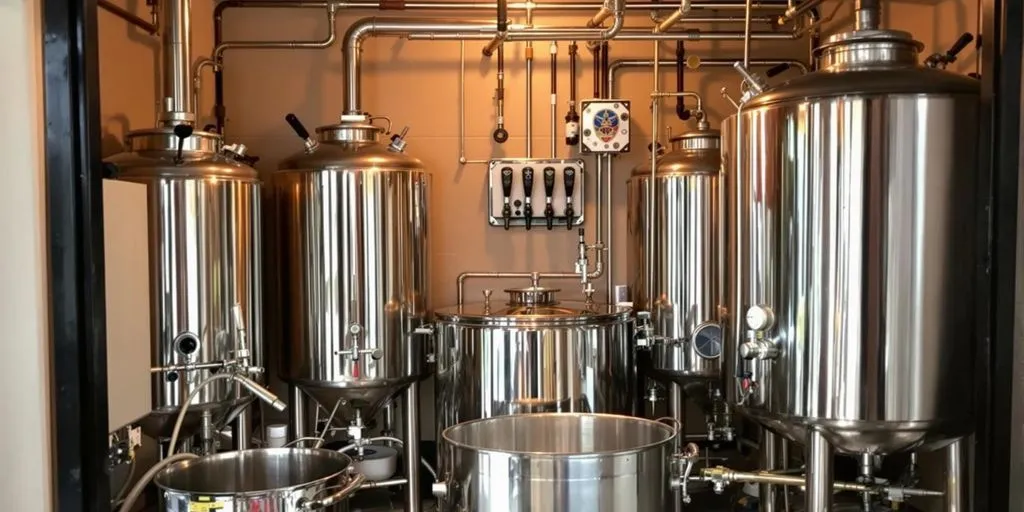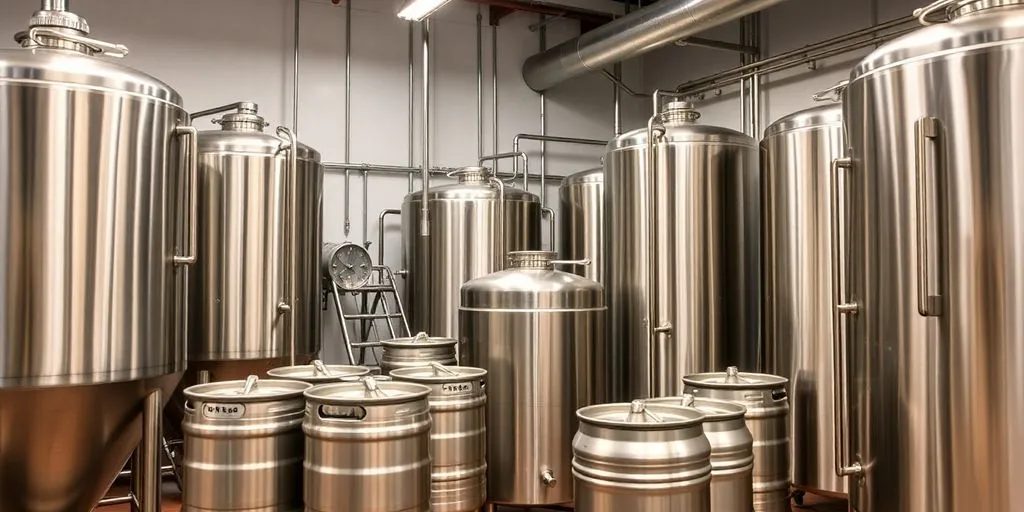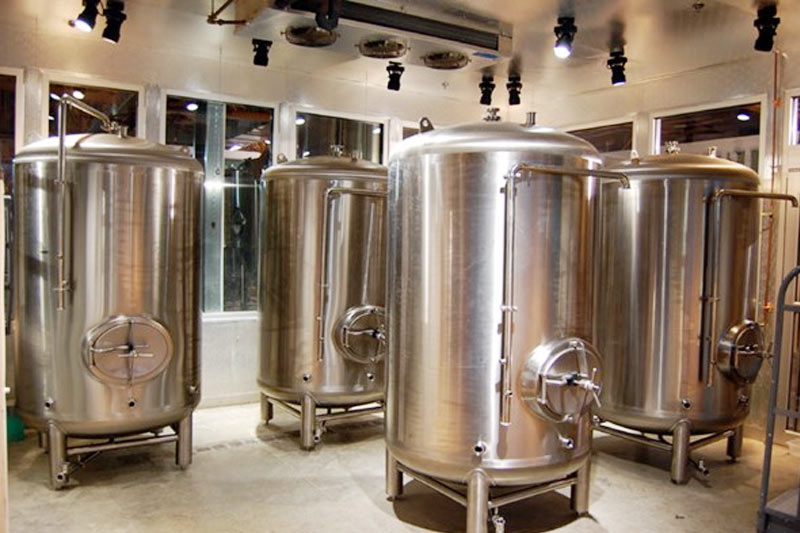Have you ever dreamed of creating your own fresh, quality beer right in your kitchen or garage? This comprehensive guide on brewing equipment is worth reading because it covers everything you need to brew beer at home, from novice-friendly starter kits to advanced all-grain systems. Throughout these sections, I will detail how to set up your homebrew process, pick the ideal stainless steel kettle, manage fermentation, and ensure you produce batch after batch of satisfying, finished beer. As someone who’s watched countless aspiring brewers take the leap, I’m eager to share insights that demystify the brewing process and help you discover just how rewarding making beer at home can be.

What Is Brewing Equipment and Why Is It Essential?
Brewing equipment often consists of the tools and vessels needed to transform grains, hops, yeast, and water into the beer you love. For many enthusiasts, pulling together a thorough selection of beer brewing equipment forms the backbone of a successful brew day. From the simplest stovetop pot to an elaborate multi-vessel brewing system, each item plays a key role in guiding the wort from raw ingredients to a finished product.
The Importance of Having the Right Gear
• Using the correct brewing supplies eliminates guesswork and ensures consistency.
• Every brewer needs at least one sturdy kettle to boil the wort, a reliable fermenter for fermentation, and a way to measure the progress of your brew.
• Investing in a wide selection of user-friendly, high-quality gear can drastically reduce mistakes, leading to better aroma, taste, and clarity in the final fluid.
Step Up Your Game
If you’re ready to step up your game, you may consider advanced pieces like a conical fermenter or even a dedicated electric brewing system that helps you maintain stable high temperatures for your batch of beer. By pairing your creativity with proven hardware, you can produce one batch of beer after another without the unpredictability sometimes found in makeshift equipment.
How Do I Get Started with a Basic Brewing Kit?
Getting started in homebrewing is more accessible than ever. Starter kits from many suppliers combine essentials such as a brew pot, a fermenter, bottle cappers, and instructions to guide you through your first attempts at making beer at home. Regardless of your skill level, it’s wise to understand each tool’s function to ensure success.
Core Tools in a Brewing Kit
A typical beginner-friendly brewing kit might include:
- A medium-sized stainless steel kettle to boil your wort
- A plastic or glass container (like a carboy) for fermentation
- A hydrometer to measure sugar content and track fermentation progress
- A thermometer for precise temperature monitoring
- Essential sanitizer to help you clean and sanitize effectively
Even though these kits vary, the homebrew equipment in them generally gives you the fundamental capacity to brew beer at a time—an ideal stepping stone to more advanced methods. If you want to try extract beer first, it’s a gentle introduction before diving into the complexities of all-grain or grain brewing.
Key Steps in the Brewing Process
• Mash or steep your grains (or extract) to extract fermentable sugars
• Bring your wort to a boil to sterilize and add hops for flavor
• Cool the wort quickly with the help of a chiller (often a plate chiller or immersion coil)
• Transfer the cooled liquid to a fermenter and pitch the yeastWith each batch size, you’ll refine your method and become more comfortable adjusting variables, eventually leading you to produce consistently delicious home brew.
Which Kettle and Burner Setup Works Best for Home Brew?
Choosing a kettle and burner might be one of your biggest decisions when building up your home brewing equipment. The kettle capacity, the material used, and whether you opt for a propane burner or an electric element can all impact the final product.
Stainless Steel Kettle vs. Aluminum
• Stainless Steel: Durable, non-reactive, and easy to clean. Many advanced brewers prefer 304 stainless steel because it resists corrosion and maintains purity in the brew. A stainless steel kettle also typically comes with options like spigots or weldless fittings for more convenient wort transfer.
• Aluminum: A cheaper alternative that heats quickly but may require additional seasoning. Some purists avoid aluminum if they fear off-flavors, but it remains popular for budget-minded homebrewers.
Burner Options: Propane, Natural Gas, or Electric
• Propane Burner: Great for flexibility and reaching boil quickly. If your brewing area is outdoors or in a ventilated garage, a propane burner is a consistent heat source to tackle bigger volumes, like a 10-gallon batch.
• Electric Brewing: Ideal for those wanting a more controlled environment or who lack outdoor space. Coupled with tools like a digital temperature probe, electric brew pots can help you dial in the heat with exceptional accuracy.(“I personally started on a simple stovetop, then upgraded to a propane burner for larger batches, and eventually switched to a dedicated electric system for better temperature control,” says an experienced brewer.)
Why a Good Mash Tun Matters in All-Grain Brewing?
If your dream is to delve into all-grain brewing, you’ll need a dependable mash tun. A mash tun is a specialized vessel that holds heated water and grains, allowing enzymes in the grains to convert starches into fermentable sugars. This step is pivotal in shaping the final beer’s color, body, and flavor.
Mash Tun Essentials
Your mash vessel should:
- Effectively insulate heat for around 60 minutes or more
- Have a spigot or drain system for racking wort to the next stage
- Accommodate the entire grain bill for your selected batch size
Often, homebrewers repurpose coolers, but a purpose-built stainless steel mash tun can optimize temperature retention, ensuring fewer surprises. Others prefer a biab (Brew in a Bag) approach, using one vessel to mash and boil, which reduces the need for multiple specialized containers.
Balancing Efficiency
High mash efficiency means better sugar extraction, which in turn leads to a better yield in your finished beer. If you insulate your mash tun adequately, maintain consistent temperature, and handle “sparging” (rinsing the grain) carefully, you’ll harness maximum flavor from your malted barley. This helps produce the kind of top-tier or “quality beer” that sets you apart at your homebrew club gatherings.
Is Temperature Control Critical for Fermentation Success?
Absolutely. Once you have your wort in a fermenter, the yeast breaks down sugars to create alcohol and CO₂ in a process called fermentation. Temperature plays a huge role in shaping beer’s flavor profile, especially if you aim to highlight subtle fruit esters or keep them minimal for a crisp lager.
Managing Fermentation Temperature
• Temperature control ensures yeast remain at their optimal range, helping reduce unwanted byproducts that might produce off-flavors.
• Many homebrewers store their carboy or plastic fermenter in a temperature-controlled fridge or a dedicated chamber.
• Some advanced setups come with built-in coil jackets or external chillers for precision.By focusing on temperature control, you can manage the “lag time” of your yeast, reduce the chances of “too much oxygen” infiltration, and coax out the exact nuance you want for your style. The difference between a well-managed fermentation and a chaotic one often boils down to a stable environment.
Concerning Sanitation and Yeast Health
In addition to stable temperature, always remember sanitation. Clean every surface the beer touches, from hoses to bottling bucket to couplers, because infection can ruin an otherwise flawless brew. The synergy between sanitized equipment and consistent temperature is the hallmark of professional-level outcomes when making beer at home.

Should You Invest in a Conical Fermenter or Stick to a Plastic Fermenter?
Many new homebrewers begin with a plastic bucket or modest glass carboys as their standard fermentation vessel. Upgrading to a conical fermenter can feel tempting if you want more convenience or a decidedly pro setup. Let’s explore the differences:
Types of Fermenters
- Plastic Fermenter: Lightweight, cost-effective, and easy to store. Good for beginners in smaller batch sizes. However, plastic can scratch easily, offering places for bacteria or wild yeast to hide.
- Conical Fermenter (often stainless steel): Allows you to remove sediment (trub) from the bottom by opening a valve, an action that helps clarify your brew. Sturdy and more durable, it is well-suited for repeated usage at high temperatures or big batch expansions.
Balancing Investment and Growth
While a conical fermenter might be pricier, its advantage in controlling trub, facilitating racking from one vessel to another, and simplifying fermentation can be a game-changer. For those eager to “time to step up your brewing or produce consistent top-tier craft,” a conical fermenter proves invaluable. However, if budget is a factor, starting with a user-friendly plastic or glass fermenter gets you in the game quickly, especially if you want to do a humble 5-gallon batch at a time.
How Important Is a Grain Mill for All-Grain Brewing?
All-grain homebrewing frequently includes using a grain mill to crush malt just before the mash. Crushing at home ensures you get the freshest possible malt profile, preserving the full range of flavors from the grains.
The Grain Mill Advantage
• Cracked barley or other grains consistently for better mash efficiency
• You control the coarseness, which affects run-off speed and potential for stuck sparges
• Reduces risk that older pre-cracked malt has lost its aroma or vital sugarsFor the best results, pair your milling procedure with immediate use of the cracked malt. If you let milled grains sit for too long, their quality can diminish, leading to a less vibrant final brew. When deciding on a grain mill (either hand-cranked or motorized), consider how often you plan to brew and whether you want to scale up your production.
Homebrewing Tip
Many advanced brewers claim that controlling your grind level is among the single most crucial elements in maintaining consistency across your entire brewing process. If your crushed grain is too fine, you might have to recirculate excessively or risk a stuck mash tun; if it’s too coarse, you’ll miss out on essential fermentables.
Which Accessories Simplify the Homebrew Bottling Process?
Bottling can be a bit tedious for some brewers, but a handful of thoughtful accessories can streamline the procedure. In fact, packaging your finished beer can become a stress-free step once you have the right gear.
Must-Have Bottling Tools
• Bottling bucket with a spigot: This dedicated pail lets you add priming sugar and blend gently for even carbonation levels.
• Bottle filler or wand: Attaches to the spigot or tubing, letting you fill each bottle from the bottom up, introducing minimal oxygen.
• Bottle caps and cappers: Keep your sanitized caps in a small dish, then use handheld or bench cappers to secure them.
• Coupler or clamp fittings: Ensures you keep good pressure lines or correct flow if hooking up a small forced-carbonation system.
Bonus Tip: Kegging vs. Bottling
While some prefer the tradition of bottling, others turn to a keg system for convenience. Kegging eliminates the constant purchasing of bottle caps and can reduce the wait time for carbonation. Plus, serving from a keg means less oxygen exposure. However, if you love the portability of bottles or enjoy handing out a few as gifts, do not overlook the joys of a well-managed bottle day.
FAQs About Brewing Equipment, Brew Day Logistics, and More
At the core, you’ll need a kettle for boiling, a fermenter for fermentation, a reliable heat source (like a burner), and sanitation tools. Also, a hydrometer helps measure sugar levels. Together, these items form the foundation of your beer making supplies.
Not necessarily. While the learning curve is steeper compared to extract methods, you’ll gain total control over flavor. Start with a complete all grain kit or a smaller scale if you want to step up your game from the start.
An accurate thermometer is key. Some prefer a built-in dial, while others watch digital probes. Either way, ensuring stable temperature throughout the boil and the mash stage leads to consistent results.
You can cool with an ice bath, but a plate chiller or immersion chiller speeds up the process significantly. Rapid cooling helps lock in aroma and lowers the risk of contamination as you approach fermentation.
Yes, you can. But joining a local homebrew group fosters shared knowledge, tips, and problem-solving. It’s also a fun way to get feedback on your batch of beer and discover new recipes or creative techniques.
If you notice big temperature drops during your mash, or if you want more precision, consider insulation or a specialized mash tun. Over time, you might decide to invest in a more advanced vessel for convenience.
Brewing Equipment Solutions and Key Takeaways
At our beer equipment manufacturing plants for products, we provide everything from simple brewing equipment configurations to advanced beer brewing equipment solutions. We know exactly what’s needed to brew superb beer. Whether you’re brand-new to homebrew or a seasoned brewer planning to scale up, we have the knowledge and hardware that will guide your journey to success.Below are five internal links for you to explore advanced systems that might spark your imagination:
- Beer-brewing-equipment – A wide selection of large-scale and compact brewing solutions.
- Nano-brewery-equipment – Great for small-scale or pilot systems if your batch size remains modest.
- Microbrewery-equipment – Perfect if you’re stepping up from homebrewing to semi-professional endeavors.
- Beer-fermentation-tank – Enables precise temperature control and capacity scaling to handle bigger volumes.
- Beer-brewing-system – Ideal for those who want an all-in-one solution that covers every stage from mashing to packaging.
Below is a random product image from our collection:

AIDA Model to Encourage Action
- Attention: As you’ve seen, brewing can be straightforward, even if you’re a newcomer with minimal resources.
- Interest: Our guide reveals how homebrew equipment, from a single kettle to a full brewing system, can help you produce high-quality, consistent beer.
- Desire: Imagine sipping your own handcrafted ale, sharing it with friends, and personalizing ingredients to craft beers that reflect your favorite flavors.
- Action: It’s time to step up your game. Contact us to explore a selection of beer brewing equipment that matches your needs, or simply learn more about advanced ways to recirculate your wort, keep your mash tun stable, and achieve professional-level results in your next batch.
Bullet Point Summary: Most Important Things to Remember
- Defining brewing equipment: Encompasses everything from brew pots and fermenter vessels to burners and hydrometer measuring tools.
- Beer at home basics: Start small with a brewing kit, mastering the fundamentals like mash, wort creation, and temperature management.
- Prioritize sanitation: Properly clean and sanitize each piece of gear, from your plate chiller to your coupler, to avoid off-flavors.
- Upgrading from extract to all-grain: A robust mash tun and optionally a grain mill let you refine your grain brewing or all-grain brewing methods.
- Tools like a stainless steel kettle or a conical fermenter can vastly streamline your brewing process.
- Manage yeast and fermentation temperatures diligently for a more refined finish, reducing the risk of harsh flavors.
- Packaging neatly into a bottle or hooking up a keg is simpler with the right accessories (like a dedicated bottling bucket with a spigot).
- Homebrewing fosters a sense of creativity—over time, you’ll dial in your own recipes and set your personal standard for quality beer.
We hope you’ve discovered how approachable (and fun) it is to produce your own beer. From selecting a modest propane burner to assembling a top-tier brewhouse setup, you can shape your brew day exactly the way you want. Ready to transform your ideas into a real pint? Reach out to our beer equipment manufacturing experts today, and let’s make your brewing vision a reality, one beer at a time. Cheers!

